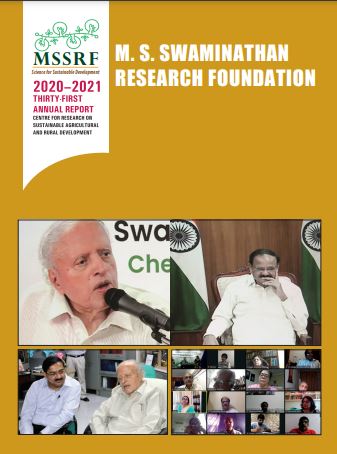In recent years, Millets have been identified as a strategic crop to address nutrition poverty. These crops are also called “Nutricereals,” and are considered a vital crop because of their climate-resilient properties. They are recommended for rain-fed agricultural systems and hill agriculture. The United Nations has also announced 2023 as the International Year of Millets.
M S Swaminathan Research Foundation (MSSRF) initiated millet research and development work in the 90s for Eastern Ghats. The activities involve a holistic value chain approach from ‘farm to fork’ to address highly interconnected aspects of conservation, cultivation, consumption, and marketing of millets. Farmers were encouraged to conserve and cultivate diverse landraces of millets belonging to different species under different cropping systems and through a wise blend of traditional and modern practices.
To establish further awareness about millets, MSSRF collaborated with Indian Council of Agricultural Research – Indian Institute of Millets Research (ICAR-IIMR) for a multi-stakeholder workshop cum seminar on millets organised on October 11, 2022, in Namakkal, Tamil Nadu. The one-day event was attended by at least 200 people including farmers, entrepreneurs, academicians, students, researchers and industrialists.


Dr. E.D.I. Oliver King, Director of Biodiversity programme at MSSRF, welcomed the gathering and explained that the workshop is a platform for farmers to share and learn about the latest advancements and best practices in millet value chains. The workshop started with the special address by Dr. Rajendra R. Chapke, Principal Scientist, IIMR, sharing work carried out at IIMR. Mr. S. Loganathan, Founder and Executive Director, ASSEFA, spoke on the need for engagement of various stakeholders and groups at the community level to revive millets. Dr. R. K Samanta, Ex-Vice Chancellor, BCKV, Mohanpur, West Bengal, talked about his work experiences on how to increase millet production and enhance income generation. Mr. S. Ramesh, DDM, NABARD, Salem cluster, gave a facilitation note and explained various schemes under NABARD. He also inaugurated the exhibition on millets, valueadded products, farming inputs and equipment, and millet processing machineries.
The workshop had three technical sessions:
First session was on millet diversity, crop improvement and production technologies, chaired by Dr. R.K. Samanta. Dr. Rajendra R.Chapke presented about national millet status, improved production and processing technologies in small millets. highlighting the important crop-cultivars developed by IIMR and success stories. He also emphasised on farming techniques and methodologies pertaining to millet cultivation.
Dr. A. Nirmala Kumari, Professor and Head, Centre of Excellence in Millets, Athiyadal, TNAU, explained the ruling cultivars of small millets in the different zones of Tamil Nadu starting from seed to production techniques to yield. She also highlighted the key features/ characteristics of ruling varieties and elaborated on the varieties that suit particular soils and climatic conditions in Namakkal and Kolli hills. She advised farmers to grow one or two millet varieties specific to their region to promote millets. Improvement of soil fertility by using soil inoculum was explained by Dr. V. R. Prabavathy, Director of Biotechnology, MSSRF. She demonstrated how farmers can produce biofertilizers and become entrepreneurs. Dr. Kalaisekar, Principal Scientist, Entomology at IIMR, spoke on the proportion of pest infestation in millets is very meagre, explaining that even in the case of infestation, plants can recover by themselves without causing much damage/yield loss.
Second session was on post-harvest processing in millets chaired by Dr. Rajendra R .Chapke. Dr M Balakrishnan, Professor and Head, Department of Food Process Engineering, TNAU, presented on the various millet-processing machineries and storage structures developed at TNAU. Two large scale and small scale millet processing machine manufacturing companies explained the availability of millet equipment – Mr. Vikram Sankaranarayan, Bonn Technologies and Mr K. Elumalai of Victor Machines.


The Third session was on nutrition, value addition and marketing of millets, chaired by Dr. E.D.I Oliver King. The nutrition profile of millets, and the importance of unpolished millet rice vs polished millet rice, and how it affects the glycemic index was explained by Dr. Shobana Shanmugam, Senior scientist and Head, Department of Diabetes and Food Technology, Madras Diabetes Research Foundation, Chennai. Dr K. A Athmaselvi, Professor and Head from NIFTEM, Thanjavur, shared about various millet value added products that were developed and marketed by their incubators. Dr. K. Jothilakshmi, Assistant professor at TNAU, spoke about various value added products developed by Community College for Home Science and income generation through value addition. Activities of a Farmer Producer Organisation at Dharmapuri District, Tamil Nadu were explained by Mr. R. Sivalingam. Mr.Yogaraj Prabhakar, SANLAK Agro Industries, Coimbatore, spoke of involvement in millet promotion in Tamil Nadu.
The farmers had a good interaction with the academicians and industrialists, particularly on millet processing machineries, and gained ideas on what millets to cultivate in cluster for better marketability. The workshop ended with a note of thanks by Mr. P. Yuvaraj from MSSRF.

